Combat aircraft. Fallen Swallow Ki-61
The name translates as "Flying Swallow", and this is the first Japanese army fighter created after the outbreak of war. The Hien was unique to Japan, as it was the only production fighter to use a liquid-cooled engine.
Many directly call Ki-61 the Japanese "Messerschmitt", but in reality with the Bf.109 it is only related to the engine. Yes, the German aircraft was like a standard, but differences in production technologies of the two countries nullified the possible similarity of the two machines.
“Swallow” Ki-61 actually became a “swan” for “Kawasaki”, who sang his song according to the company's ambitions. And a kind of monument of faith "Kawasaki" in a fighter with an in-line liquid-cooled engine. And with a rebuke, a reminder that the Japanese engineers could not bring this engine to mind.
But one cannot take away the fact that not a single Kawasaki aircraft has been built for such a long time and in as many modifications as the Ki-61.
It all began in the 1937 year, when Kawasaki greatly lost its position as a manufacturer of aircraft. The dashing guys from Nakajima were stronger. And it was necessary to do something.
I must say that the new director of the Blom and Foss company, Dr. Vogt, the former chief designer of Kawasaki, provided great help to Kawasaki. It is sometimes useful to have such friends. So, through the efforts of Dr. Vogt, the Japanese got at their disposal the DB-601A engine from Daimler-Benz and a friendly permit for licensed production.
The agreement was signed in 1939 at the very end, and in February 1940 the army headquarters aviation issued "Kawasaki" contracts for the heavy interceptor Ki-60 and light fighter Ki-61 with German engines. The war in Europe by that time was already in full swing and the successes of the Germans reached Japan.
With the interceptor Ki-60 did not work, the plane was very heavy and did not arouse interest among the army pilots. But with the Ki-61 it did. It was designed as a lightweight fighter to replace the Ki-43 Hayabusa fighter. Ki-61 was heavier and faster, was more powerful armed, although it lost Ki-43 in maneuverability.
By July 1941 of the year, Kawasaki launched DB.601A into production under the name Kawasaki Ha-40. The prototype Ki-61-01 with this engine was ready in December 1941, and a few days later Japan entered World War II.
At the beginning of the 1942 year, the prototype reached a maximum speed of 587 km / h during testing. The Kawasaki were pleased with the results and began to release a test series.
True, enthusiasm decreased somewhat after a series of accidents and disasters. Several prototypes were lost, including the Kawasaki Kataoka chief pilot. The causes of the problems were identified, the Ha-40 engine was to blame, which, unlike the German original, turned out to be extremely capricious and not very reliable.
However, tests conducted with Japanese scrupulousness showed that the Ki-61 was in almost all respects better than the Ki-43-II, Ki-44, the trophy American P-40E and even the Messerschmitt Bf.109 E-2. Such conclusions were made on the basis of numerous training battles at the Kagamigahar Army Test Center.
As a result, in August 1942, the aircraft was adopted by the Kawasaki Type 3 Model I “Hien” or Ki-61-I.
But by this time the enemy was aware of the appearance of a new fighter among the Japanese. Back in April of 1942, during a test flight, test pilot Umikawa of a test flight suddenly came across a group of B-25 bombers. It was a group of captain Doolittle who made the first combat raid on Japan.
Umikawa chased the bombers, but was forced to stop the chase due to lack of fuel. But the crews of American aircraft were able to consider an unusual for Japan "skinny" fighter, very similar to the Messerschmitt.
For a long time, Americans believed that the Japanese Air Force was armed with either purchased in Germany, or produced under the license "Messerschmitts", which should be expected in other parts of the Pacific Ocean.
In general, given the reputation that the Messerschmitts deserved by 1942, this did not add optimism to the Americans.
But in fact, Ki-61 met with American aircraft in battle only a year later. But this year, changes in the Pacific theater of operations will not happen in favor of the Japanese, and Ki-61 will be one of the last hopes to counter these changes.
When the army is victorious, things usually go quietly. But when the army loses, panic sets in and it is far from always possible to adequately respond to the situation. We have often witnessed historical events when the command simply begins to throw everything that can be tucked into the battle.
This happened with the debut of the Ki-61, whose crews threw them into a meat grinder in New Guinea. It is worth recalling that the Ki-61 in terms of aerobatics was fundamentally different from the usual Ki-43. They were faster, but not so maneuverable, which affected the training of pilots.
Units armed with Ki-61 fought in the Solomon Islands, in New Guinea, defended transport convoys going to New Britain, New Ireland.
The first Ki-61-Ia model deployed in New Guinea at the end of the 1943 year was joined by new Ki-61-Ib fighters with armament from four 12,7-mm machine guns.
The war on the islands, where the Swallows carried the main combat load on their wings, revealed another problem, the problem of servicing and repairing aircraft.
Japanese aviation could not boast of a large number of really trained technicians. For the bulk, accustomed to air-cooled engines, the Na-40 engine was still that puzzle.
Failures of the hydraulic system, leaks of pipes and radiators, engine breakdowns caused the already not very reliable Na-40 to simply plane the planes to the ground.
Potentially magnificent fighter was too unreliable. A huge number of immobilized and useless "Swallows" accumulated in the jungle around the airfields in New Guinea. Spare parts were in short supply and often mechanics from several aircraft assembled one that could fly into the air.
In addition, very often spare parts did not come, because the ships transporting them became a victim of American submariners or pilots.
Plus a huge stretch of the theater of operations. For example, a plane that crashed in New Guinea could only be overhauled in the Philippines, in Manila, where it had to be sent by ship, almost 1000 kilometers away.
Despite many problems, the “Swallow” enjoyed both the hatred of the mechanics (well-deserved) and the love of the pilots.
Yes, the plane was not as maneuverable as the Ki-43, but by Japanese standards it was almost a flying tank, with well-designed tanks, an armored back for the pilot, and a German-style armored head.
Still, being considered heavy and awkward by Japanese standards, the Ki-61 outperformed all American aircraft until the arrival of the latest F6F Hellcat and P-51 Mustang.
P-40 and P-39 definitely lost Ki-61 both vertically and horizontally. And in a disadvantageous situation, the Ki-61 pilot could always get out of combat in a dive. Only in the battles with the twin-engine P-38 this technique did not pass, but in the battles with the Lightning the Ki-61 pilot did not need this, since the advantage in maneuverability was more than sufficient. Armored Ki-61 pilots were generally more aggressive than their Ki-43 counterparts.
On 30 December 1943, the allies at the former Japanese airfield of Cape Gloucester captured the first practically intact Ki-61. The Americans quickly flew around the Japanese fighter, noted that the Ki-61 or "Tony" according to the American naming system was pleasant in piloting, quite energetic, easy to operate. It was also noted that it is difficult for the Japanese to keep the aircraft in technically sound condition.
During the battles in New Guinea, several attempts were made to increase the effectiveness of the Ki-61, which clearly lacked firepower. To combat strong and tenacious American bombers, machine-gun weapons were obviously not enough.
Japanese industry was not able to meet the requirements of the army to organize the production of aircraft guns. But here, representatives of the army aviation themselves “helped” themselves, who did not want to put “99 Type” sea guns on their planes. Bullshit, of course, but there were such things in that Japan.
The Germans rescued, sending on board a submarine in Japan 800 guns MG-151.
I had to strengthen the wings of the Ki-61-I for the installation of German guns, which had significant recoil force. When installing the MG-151 gun, they had to be turned on their side to fit in the relatively thin Ki-61 wing, covering the protruding parts of the breech with small fairings on the lower surface of the wing.
By June 1944, all German guns had been used and 388 Ki-61 fighters were equipped with Mauser products.
An attempt was made to further strengthen the armament by replacing the 12,7-mm wing machine guns with the No.155 cannons in the 30 mm caliber. So the Ki-61-I-Kai-d model appeared in a small series, but the production did not last long, it turned out that the return of the 30-mm guns simply destroys the wing.
But in 1945, the sunset of the "swallows" began. Mustangs appeared. And here it is worth giving an example when, in one of the last air battles for the Philippines 11 on January 1945, two American P-51 pilots performing reconnaissance flights met a Japanese naval bomber G4M converted into a transport that was accompanied by twelve (!) Ki-61 fighters .
Not only did the American pilots attack the superior enemy together in the best traditions of the Soviet colleagues, they shot down nine Ki-61 and the transport bomber accompanied by them.
On board this G4M were Japanese staff officers fleetwho were evacuated from the Philippines ...
This shows how the level of training of Japanese pilots has fallen after the catastrophic losses in New Guinea, Leyte and the Philippines.
The last battle, in which Ki-61 took part, was the battle for Japan.
These aircraft used a variety of weapons variations. Somewhere, the "Swallows" were deprived of machine guns in order to lighten the aircraft as much as possible and get to the B-29 flying at an altitude of 9 km. Other units added additional 20-mm Ho.5 guns, bringing the Ki-61 armament to 2x20-mm synchronous guns in the fuselage, a couple more in the wings and 2x12,7-mm machine guns in the wings. Sometimes machine guns were dismantled.
In general, field alterations of who was what.
The whole point was that before the B-29, which began to terrorize the Japanese islands from an altitude of 9 km, of all Japanese fighters, only Swallows could normally get and attack. In this regard, the Ki-61 was the only single-seat fighter that could not only climb to a height above 9000 m, but also maintain combat effectiveness there without the risk of falling into a tailspin.
But even for him it was necessary to lighten the plane as much as possible, often by removing most of the weapons from the fighter. This put Ki-61 pilots at an even more disadvantageous position in trying to attack the machine-gunned bomber on their nearly disarmed fighters.
Or they used this technique: in order to maintain firepower, the Ki-61 took off with a pair of hanging tanks, but with an almost empty main one. Upon entering the attack, the PTBs were reset, facilitating the aircraft, but in the main tank of fuel there was only one attack.
Many of the pilots were recent graduates of flight schools, which they graduated with only a few hours of combat flight training. This was a necessary measure due to the extreme shortage of fuel in Japan. Hence the complete inability to at least do something with the B-29, but then it’s known that there were rams.
In general, it came to complete stupidity: the pilots began to disarm their aircraft in order to improve flight performance. By 1945, “special attacks” had become the usual way of resisting both aircraft and ships.
It is worth mentioning that during the war, the Kawasaki company worked on the 2 and 3 modifications of the Ki-61. It was planned to install a new, more powerful Na-140 engine, but in 1944 the year was not up to it, fortunately, there were enough problems with the predecessor, Na-40.
So Ki-61 fought the whole war in its original form, only weapons changed. From 2 x 7,7-mm and 2 x 12,7-mm machine guns to 4 x 20-mm guns.
The Swallow received further development in the Ki-5 Type 100 fighter project, but that's another story. And the career of Ki-61, ended in China after the end of World War II.
A number of captured Ki-61s fell into the army of Mao Jie Dong and quite normally participated in battles with the army of Chiang Kai-shek, with Japanese pilots sitting at the controls. But over time, the Ki-61 was replaced by more modern Mustangs and La-11.
Thus ended the career of the first Japanese army fighter with a liquid-cooled engine.
The plane was not bad, probably this is the best that could be created by the hands of Japanese engineers. In many sources it is for some reason called either a copy of Bf.109, or a copy of the Italian MC.202, but still it was a Japanese plane. Which, alas, did not reach the originals at all, which were attributed to him.
If the Kawasaki engineers could not only copy the DV601A, but also modernize it as the Germans did, the output could be a completely different plane.
But, as you know, history does not know the subjunctive mood. And Ki-61 remained in history as a largely advanced, but not brought to mind plane.
LTX Ki-61-II
Wingspan, m: 12,00
Length, m: 9,16
Height, m: 3,70
Wing area, м2: 20,00
Weight, kg
- empty aircraft: 2 840
- normal takeoff: 3 780
- Maximum takeoff: 3 825
Engine: 1 x Kawasaki Ha-140 x 1500 hp
Maximum speed km / h: 610
Cruising speed, km / h: 450
Practical range, km 1 600
Combat range, km: 1 100
Maximum rate of climb, m / min: 835
Practical ceiling, m: 11 000
Crew, prs: 1
Armament: two synchronous 20-mm guns Ho-5 and two 12,7-mm wing machine guns. 2 bombs 250 kg.
Source:
Aranov E. Kawasaki Ki.61 / Ki.100 "Hien" / "Tony".
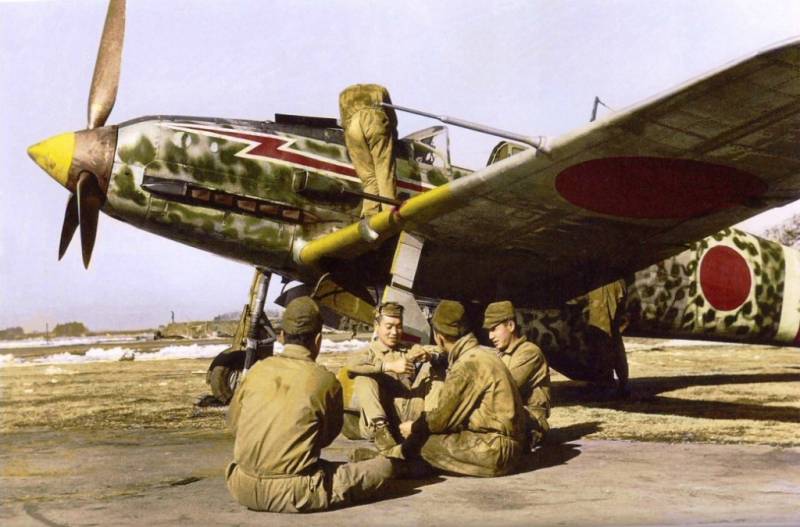
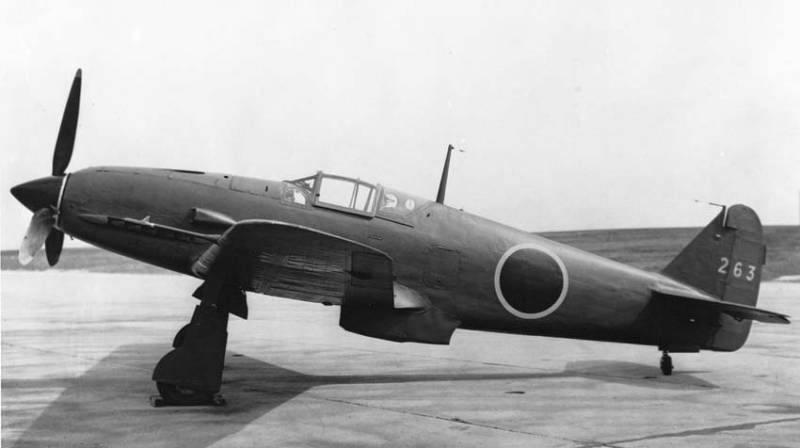
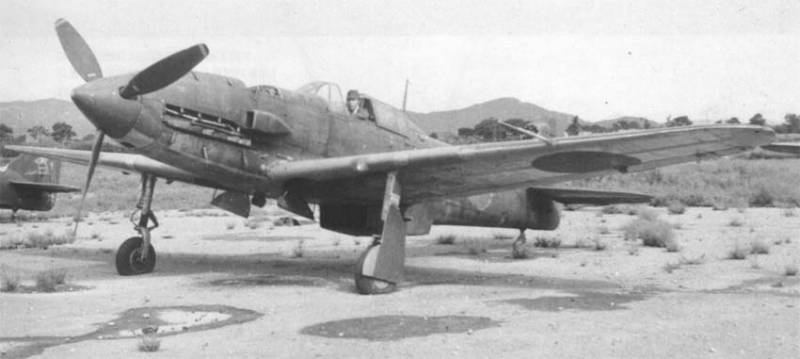
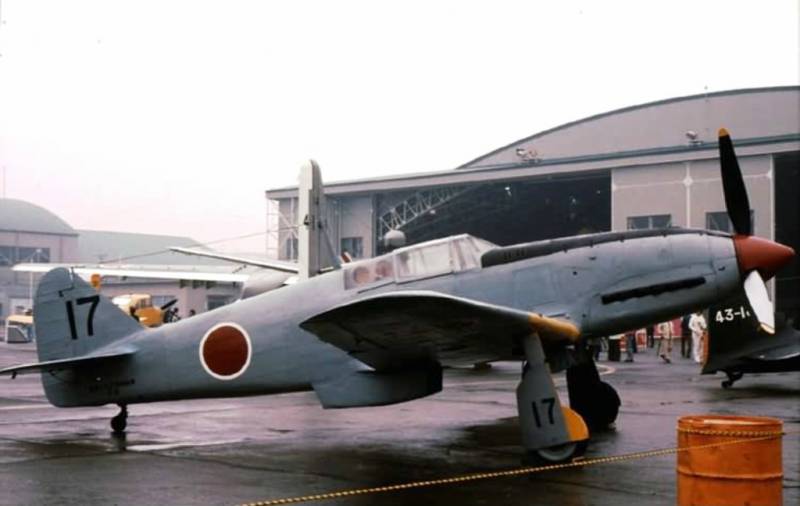
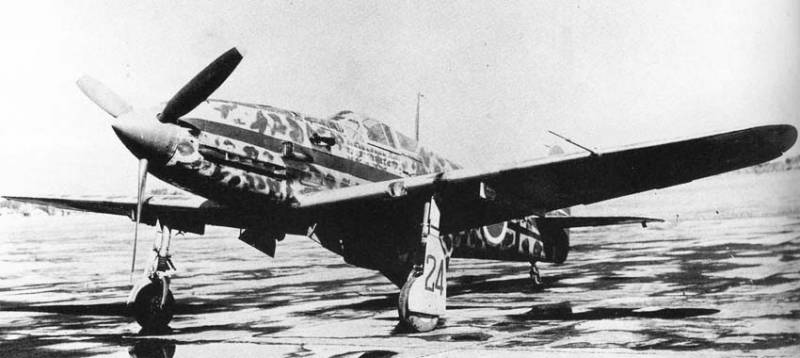
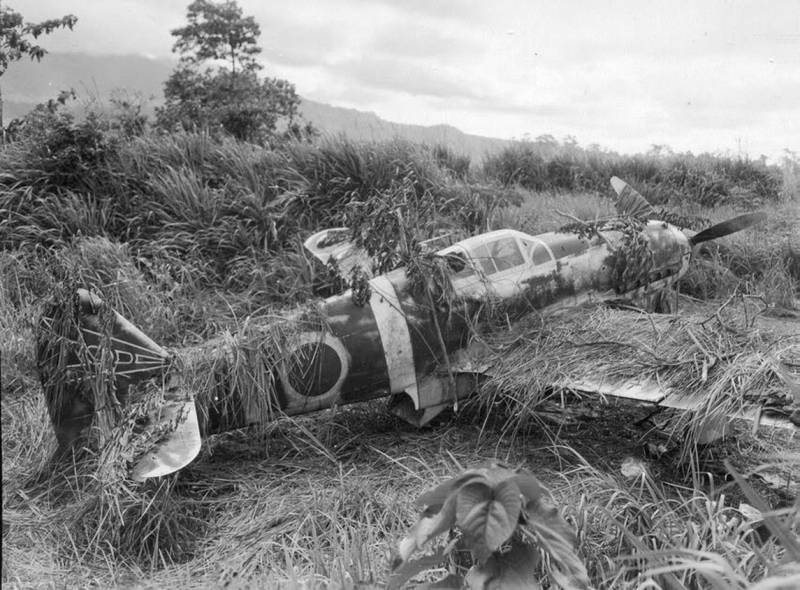
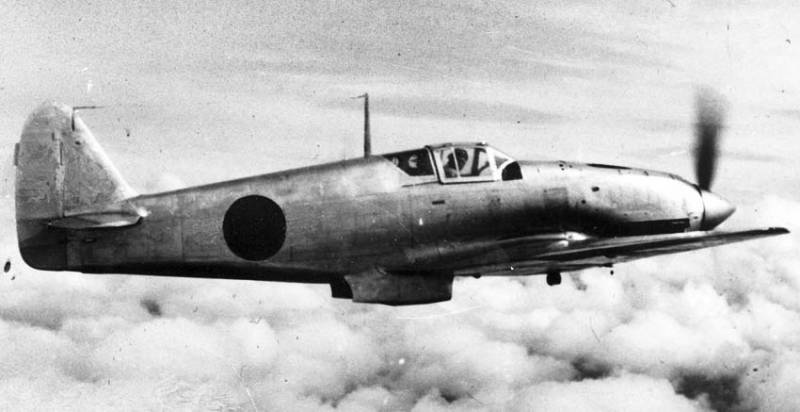
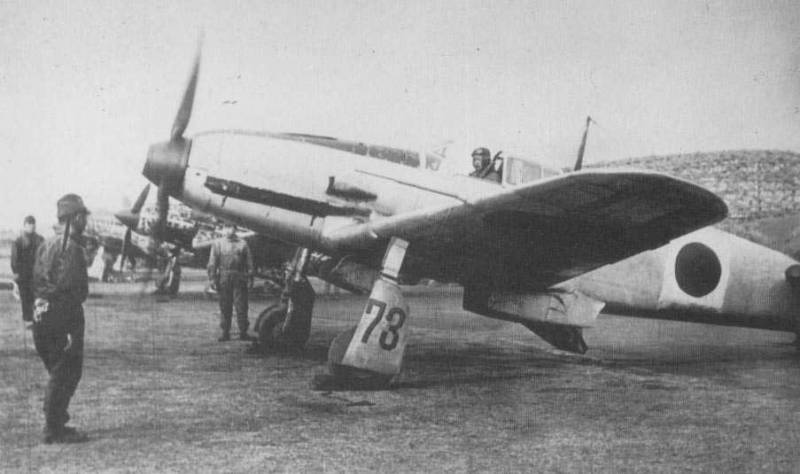
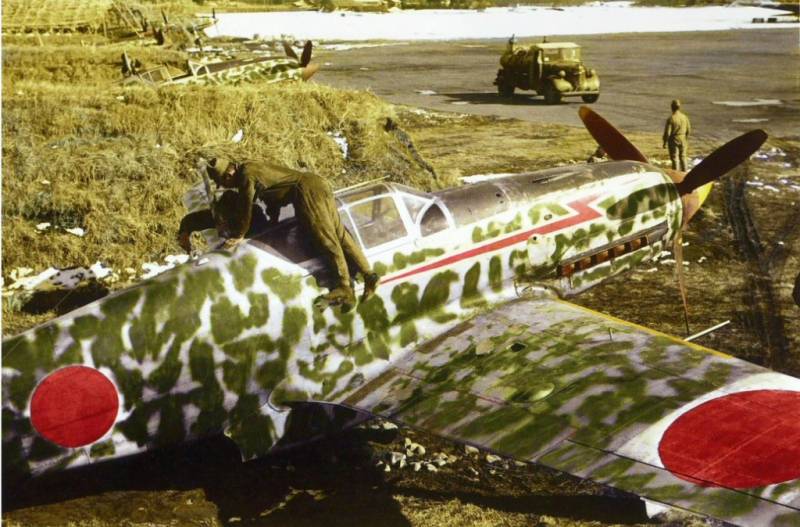
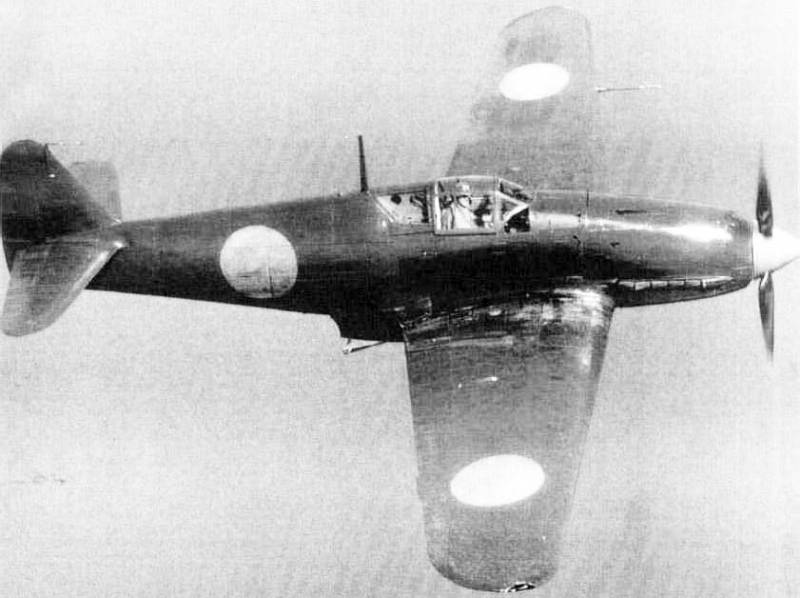
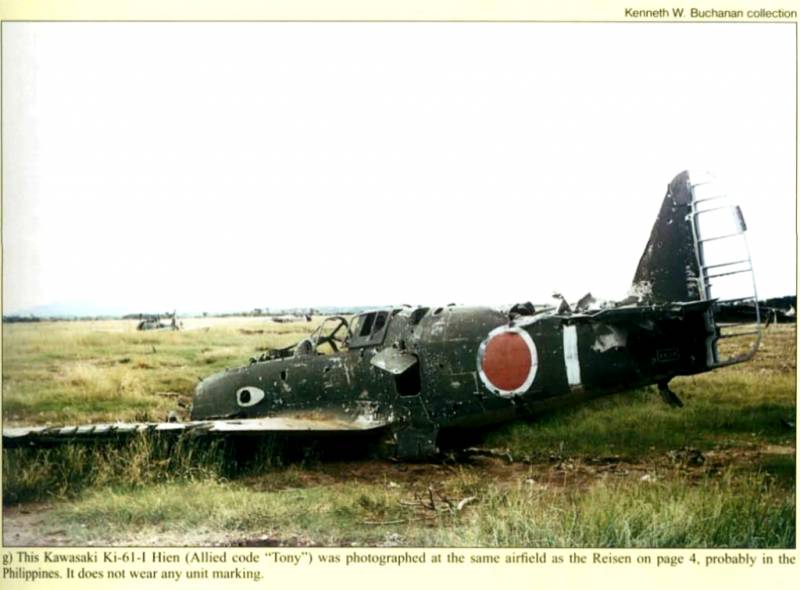
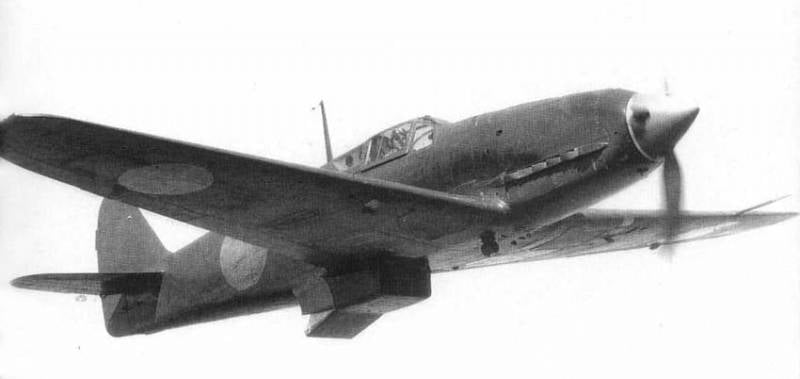
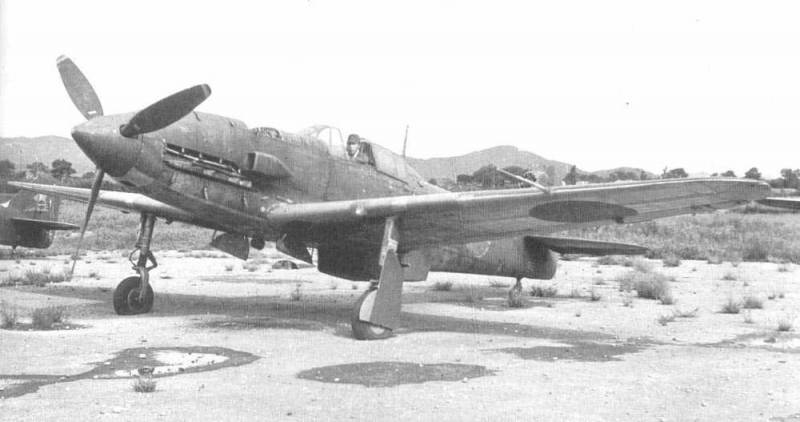
Information